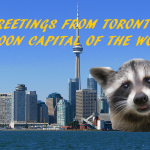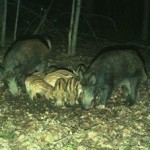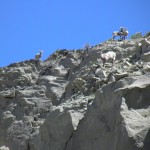
A “Nature” documentary salutes Toronto’s high density of urban wildlife, but tourism officials want to hide their light under a bushel.
Keep reading Toronto snubs “Raccoon Capital of the World” title
 A “Nature” documentary salutes Toronto’s high density of urban wildlife, but tourism officials want to hide their light under a bushel. Keep reading Toronto snubs “Raccoon Capital of the World” title  Feral hogs are now in NY. The USDA says they come from game farms, especially one on the PA-NY border. Keep reading Feral hogs now roam NY, thanks to releases by hunters  Mountain Goats–officially deemed an invasive, are controversial in Yellowstone–though everyone agrees they’re fun to see. You can find them near Mammoth. Keep reading Yellowstone Mountain Goats: Officially Unwelcome, Unofficially Pretty Neat  Right Before He Froze…,courtesy of Kafe Soleil. Florida’s cold snap could provide the big check on invasive species biologists have been wanting for decades. We could see less iguanas and pythons–and also fewer more beloved animals such as parrots. Even animals that didn’t die in the cold could die of a cold in coming weeks. “I expect we’re going to have huge, huge mortality, maybe even in Miami itself,” says Florida Fish and Wildlife Commission invasive species expert Scott Hardin. “Those that didn’t die [from the cold] could easily die of a respiratory infection.” The Everglades’ infamous python invaders were at least cold-stunned and perhaps hurt worse. Researchers found that 10 of 11 of the giant snakes they tracked weren’t moving, Hardin said. He added that he didn’t have word yet on the giant parrot colonies that live around the state, especially Miami. Given the hurt the freezing temperatures caused Floridians, Hardin didn’t want to sound too gleeful. But he so clearly was. The non-natives can push out species that naturally belong, and they’ve been running amok for 30-40 years, the last time Florida saw weather this harsh. A few of the more vulnerable native animals were also hurt by the wintry blast. Hundreds of sea turtles were rescued, but hundreds more found dead, according to Hardin. The state did get to tag and collect information on lots of endangered green turtles. Florida got a record count of manatees (5,067) because they’re easier to see when they’re crowded around Keep reading Cold Snap–Or At Least Colds–May Push Back Florida Invasives  Florida’s harsh cold spell is a bonanza for animal watchers, if not for the Florida animals themselves. Manatees are gathering around power plants and hot springs. Iguanas are dropping from trees in a kind of cold coma. Cold-stunned turtles are warming up in hotel rooms. Pythons are sunning themselves. And waterfowl are migrating down from other states, says Gary Morse, a spokesman for Florida’s Fish and Wildlife Commission. Manatees: The manatees are the ones wildlife officials are worried about. They’re native, endangered and hate the cold. Sea cows need water at least 68 degrees to survive. Last year at least 56 died of cold stress, the FWC says. This year they’d like people to give them a break and back off for a bit. “They are stressed from the cold and from not eating. We advise people not to approach them in these times,” Morse says. “Our mere presence as human beings can cause them to flee the very thing they need.” The FWC already pulled two frigid manatees from cold water and sent to a zoo and an aquarium to warm up. Sea Turtles: Sea Turtles often turn up at the same hot spots that draw manatees. But if they don’t they become sluggish and eventually get cold-stunned and beach themselves. Rescuers are swooping in and taking them to the The Turtle Hospital on the Keys and the Georgia Sea Turtle Center have resorted to putting them up in hotel rooms and kiddie pools, respectively. View AnimalTourism.com Keep reading Iguanas Dropping, Manatees Gathering, Pythons Surviving in Florida’s Cold  Boston loves to show off its sweet, staring role in Make Way for Ducklings, the children’s book that culminates in cops helping ducks across the street. They’ve got duckling statues, duckling contests and it is seemingly mandatory to display the book in stores. Yet the city isn’t helping its non-fiction waterfowl. For nearly three decades a flock of white and gray geese have lived on the Charles River near Boston University, but their advocates say a renovation plan is pushing them out. “They insist they have this beautiful park but they have no use for free animals,” says Robert J. La Trémouille, a blogger who is one of the Friends of the White Geese, which is kind of the like the geese’s political lobbying arm. This flock of 60-80 White China, Emden, and Toulouse geese have lots of friends and fans. La Trémouille says Bostonians have visited geese–a rare survivor on the polluted Charles–since at least 1981, when a plant got “guard geese.” But some say the geese go back 60 years. Another group, the Charles River Urban Wilds Initiative, concern themselves with the geese’s day-t0-day care. Many, like Boston University writing lecturer Allison Blyer, take it on themselves to deliver healthy food (veggies, duck food) and occasional medical care. They notice individual characters and quirks. The current leader, Buddy, is about 20 years old. Pinky, pictured above, is known as a real character, sayd Blyer: “He is very bonded to us and likes to peck cameras. Keep reading Boston Won’t Make Way For Geese |
|
|
Copyright © 2024 AnimalTourism News - All Rights Reserved |
|
Recent Comments